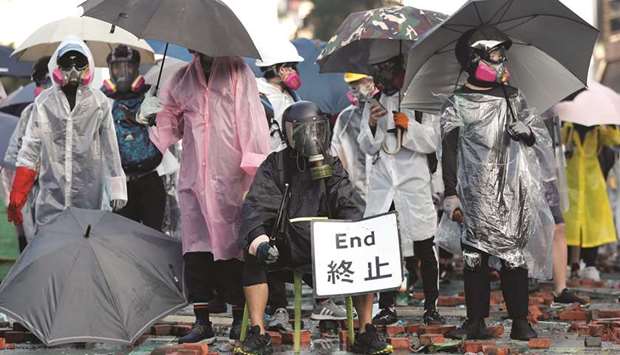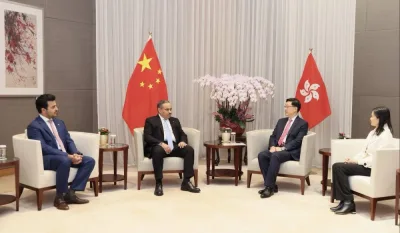A police officer was struck by an arrow fired by a Hong Kong protester yesterday and an armoured vehicle set ablaze, as fierce clashes raged into the night around a campus which has turned into a base for a pro-democracy movement whose protests have plunged the city into turmoil.
Protests have tremored through the global financial hub since June with many in the city of 7.5mn people venting fury at eroding freedoms under Chinese rule.
China has repeatedly warned that it will not tolerate the dissent, and there have been concerns that Beijing could send in troops to put an end to the unrest. Chinese President Xi Jinping this week issued his most strident comments on the crisis, saying it threatened the “one country, two systems” model under which Hong Kong has been ruled since the 1997 handover from Britain.
Yesterday activists dug in at Hong Kong Polytechnic University (PolyU) vowing to defend it from police and to maintain a blockade on the nearby Cross Harbour Tunnel, which has been closed for several days. As dusk fell, police tried to retake a footbridge over the tunnel but were met by a barrage of petrol bombs that caused a huge fire.
Later an armoured vehicle edged towards protesters encamped on a flyover near the university, who met it with a flurry of petrol bombs setting the vehicle alight, according to live-streamed video of the incident shown by several local media. The driver was forced to retreat and the fire was extinguished as protesters appeared resolute in their desire to turn the campus into a hub - a twist in tactics by a leaderless movement so far defined by its fluid, unpredictable nature. “We need a base to keep our gear and have some rest at night before another fight in the morning,” said a 23-year-old PolyU student called Kason.
Earlier, activists parried attempts by police to break through into the PolyU campus, firing rocks from a homemade catapult from the university roof. An AFP reporter saw a team of masked archers - several carrying sports bows - patrolling the campus. Police shared images of an arrow embedded in the calf of an officer outside the campus and decried the use of “lethal weapons,” declaring the campus a “riot scene” - a rioting conviction carries up to 10 years in jail.
Activists have vowed to wreak further havoc today, in a follow-up to a week of chaos which left city streets strewn with debris and saw white-collar workers take to the streets in support of the frontline protesters. Demonstrators last week engineered a “Blossom Everywhere” campaign of blockades and vandalism, which forced the police to draft in prison officers, shut down large chunks of Hong Kong’s train network and closed schools and shopping malls. The movement, characterised by its fluidity and unpredictability, has started to coagulate in fixed locations, showing their ability to switch tactics.
The protests started against a now shelved bill to allow extradition to China but have billowed to encompass wider issues such as perceived police brutality and calls for universal suffrage in the former British colony. Two people have died this month as the violence worsened, while the financial hub has been pushed into a recession by the turmoil. Hong Kong’s airport authority yesterday said October traffic figures were down 13% on last year with 5.4mn passengers as the economy takes a battering.
A poster circulating on social media called for the “dawn action” to continue today. “Get up early, directly target the regime, squeeze the economy to increase pressure,” it said. The education bureau said schools will remain closed again today. Earlier yesterday, dozens of pro-government supporters gathered to clear barricades near the university campus - a sign of the divisions slicing through the city.
Many residents are wearied by the sapping protests. Others support the Chinese-backed city government.
Some applauded a Saturday cameo in a clean-up by Chinese troops from a garrison of the People’s Liberation Army in Kowloon, who burst from the barracks in a rare and highly symbolic appearance on Hong Kong’s streets. The garrison is usually confined to the barracks under Hong Kong’s mini-constitution, although it can be deployed under the request of the city’s government to help with public order breakdown or natural disasters. Hong Kong government, which presides over a city that enjoys greater freedoms than the mainland, said it did not ask the PLA for help on Saturday.
The choreographed troop movement “has only compounded the impression that Beijing has simply ignored” Hong Kong’s unique political system, said analyst Dixon Sing.

Protesters are seen during clashes with police outside Hong Kong Polytechnic University (PolyU) in Hong Kong.


